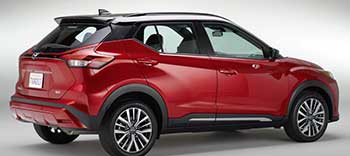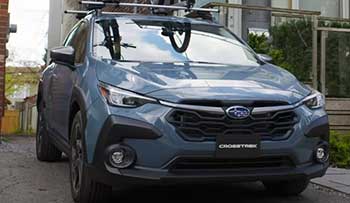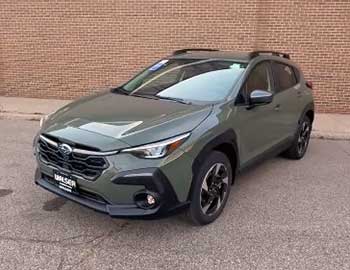
I recently set out to compare two popular subcompact SUVs, the 2025 Nissan Kicks and the 2025 Subaru Crosstrek, to determine which offers the best value, performance, and features for everyday drivers like you and me.
As someone who values practicality, efficiency, and modern tech in a vehicle, I explored their strengths and weaknesses, from fuel economy to off-road capability. This article breaks down my findings, highlighting pros, cons, and key features to help you decide which SUV suits your lifestyle.
Below, I’ve included a comparison table and detailed insights to guide your choice.
Comparison Table
| Feature | Nissan Kicks (2025) | Subaru Crosstrek (2025) |
|---|---|---|
| Starting MSRP | $27,199 (CAD) | $29,495 (CAD) |
| Engine | 2.0L 4-cylinder, 141 hp, 140 lb-ft torque | 2.5L 4-cylinder, 182 hp, 178 lb-ft torque (most trims) |
| Fuel Economy | 8.4/6.9/7.7 L/100km (city/hwy/combined) | 9.4/8.1/8.8 L/100km (city/hwy/combined) |
| Drivetrain | FWD, optional AWD | Standard AWD |
| Cargo Space | 30.0 cu ft (seats up), 60.0 cu ft (seats down) | 19.9 cu ft (seats up), 60.0 cu ft (seats down) |
| Ground Clearance | 7.0 inches | 8.7 inches (9.3 inches in Wilderness trim) |
| Safety Features | ProPilot Assist, 10 airbags, Top Safety Pick | EyeSight, 7 airbags, Top Safety Pick (2023) |
| Infotainment | Dual 12.3-inch displays (higher trims) | 11.6-inch touchscreen, STARLINK system |
| Warranty | 36 months/60,000 km comprehensive | 36 months/60,000 km comprehensive |
My Experience With Nissan Kicks
When I first got behind the wheel of the 2025 Nissan Kicks, I was struck by its bold, redesigned look. The tri-bar running lights and two-tone color scheme gave it a modern, urban vibe that felt fresh compared to its predecessor. Driving through city streets, the Kicks felt nimble and easy to park, thanks to its compact size—4.5 inches shorter than the Crosstrek.
Its 2.0-liter engine, producing 141 horsepower, provided enough pep for daily commutes, though it’s not a speed demon. The optional all-wheel drive was a nice surprise, adding versatility for light snow or rain, but front-wheel drive is standard, keeping costs down.
The interior impressed me with its upgraded materials and spacious feel, especially for a subcompact SUV. The available dual 12.3-inch displays were crisp and intuitive, making navigation and media control a breeze. Cargo space was a standout, offering 30 cubic feet with seats up, perfect for grocery runs or weekend getaways.
Safety features like Nissan’s ProPilot Assist, which includes semi-autonomous driving, felt like a premium touch for the price. However, I noticed the ride could feel stiff on rough roads, and the engine struggled a bit on steep inclines. Overall, the Kicks felt like a budget-friendly, stylish option for city dwellers who prioritize efficiency and tech.
My Experience With Subaru Crosstrek

The 2025 Subaru Crosstrek, on the other hand, felt like it was built for adventure. Its standard all-wheel drive and 8.7 inches of ground clearance (9.3 in the Wilderness trim) made it a confident choice for tackling Chicago’s snowy streets or light off-road trails.
The 2.5-liter engine, standard on most trims, delivered 182 horsepower, offering noticeably more power than the Kicks. I found the ride smooth and composed, though the steering felt a bit vague, and there was some body roll in corners. It’s not a sporty SUV, but it’s reliable for daily driving and beyond.
Inside, the Crosstrek’s STARLINK system with an 11.6-inch touchscreen was user-friendly, and the wireless Apple CarPlay and Android Auto integration kept me connected. The seats were comfortable, especially with the water-repellent StarTex upholstery in the Wilderness trim, perfect for muddy adventures.
However, the cargo space (19.9 cubic feet with seats up) felt cramped compared to the Kicks, and the interior design leaned utilitarian rather than luxurious. The Crosstrek’s EyeSight safety suite, including adaptive cruise control, was reassuring, but I found the driver aids overly sensitive at times. It’s a solid pick for those who value all-weather capability and durability.
Read more: My Thoughts on GMC Terrain Vs. Ford Escape
Pros Of Nissan Kicks
- Affordable Price Point: Starting at $27,199 (CAD), the Kicks is notably cheaper than the Crosstrek, making it a great choice for budget-conscious buyers looking for value without sacrificing features.
- Impressive Fuel Economy: With 8.4 L/100km in the city and 6.9 L/100km on the highway, the Kicks outperforms the Crosstrek in efficiency, saving you money at the pump.
- Generous Cargo Space: The Kicks offers 30 cubic feet of cargo space with seats up, significantly more than the Crosstrek’s 19.9 cubic feet, ideal for shopping or travel.
- Advanced Technology: Higher trims feature dual 12.3-inch displays and NissanConnect, providing a modern, tech-savvy cabin experience with seamless smartphone integration.
- Top-Notch Safety: The Kicks earned a 2024 IIHS Top Safety Pick rating, with 10 airbags and ProPilot Assist, offering peace of mind for families and commuters.
- Compact and Maneuverable: Being 4.5 inches shorter and lighter than the Crosstrek, the Kicks is easier to park and navigate in tight urban environments.
- Free Maintenance: Nissan covers scheduled maintenance for 2 years or 24,000 miles, including oil changes and tire rotations, reducing ownership costs.
The Kicks’ affordability and efficiency make it a standout for city driving. Its redesigned exterior, with bold styling cues like tri-bar lights, adds a premium feel without a premium price. The spacious cargo area was a game-changer during my test drives, easily accommodating bulky items.
The tech, especially the large displays, felt cutting-edge for a subcompact SUV, and the safety features rival those of pricier vehicles. While it’s not built for rugged terrain, the optional AWD and lightweight design make it versatile enough for most weather conditions.
Cons Of Nissan Kicks
- Underpowered Engine: The 2.0-liter engine’s 141 horsepower feels adequate for city driving but struggles on highways or steep inclines, lacking the Crosstrek’s punch.
- Stiff Ride Quality: The suspension can feel harsh on uneven roads, making long drives less comfortable compared to the Crosstrek’s smoother ride.
- No Standard AWD: Unlike the Crosstrek, AWD is optional, which may disappoint buyers in regions with frequent snow or rain.
- Limited Off-Road Capability: With only 7.0 inches of ground clearance, the Kicks is less suited for off-road adventures than the Crosstrek’s rugged design.
- Smaller Rear Legroom: The Kicks offers 34.5 inches of second-row legroom, less than the Crosstrek’s 36.5 inches, which may feel cramped for taller passengers.
- Basic Base Trim: The entry-level Kicks lacks some premium features, like satellite radio, which are standard on higher Crosstrek trims.
- Plastic Fuel Tank Concerns: While designed to withstand impacts, the plastic fuel tank may raise durability concerns for some buyers compared to metal alternatives.
The Kicks’ engine felt underpowered when I pushed it on highways, and the ride quality wasn’t as smooth as I’d hoped on bumpy roads. The lack of standard AWD was noticeable in wet conditions, where the Crosstrek felt more planted.
Rear-seat passengers might feel squeezed, and the base trim’s lack of features like satellite radio disappointed me. While the Kicks excels in urban settings, it’s not the best choice for those needing rugged versatility or a more refined ride.
Pros Of Subaru Crosstrek

- Standard All-Wheel Drive: The Crosstrek’s AWD is standard across all trims, providing superior traction in snow, rain, or light off-road conditions.
- Powerful Engine Options: The 2.5-liter engine (182 hp) in most trims offers better acceleration and performance than the Kicks’ 141-hp engine.
- Off-Road Capability: With 8.7 inches of ground clearance (9.3 in Wilderness trim), the Crosstrek handles trails and rough terrain better than the Kicks.
- High Safety Ratings: The Crosstrek earned a 5-star NHTSA rating and a 2023 IIHS Top Safety Pick, with EyeSight features like adaptive cruise control.
- Spacious Interior: Offering 36.5 inches of rear legroom, the Crosstrek provides more comfort for backseat passengers than the Kicks.
- Reliable Brand Reputation: Subaru ranks higher in reliability (11th vs. Nissan’s 16th by Consumer Reports), appealing to buyers seeking longevity.
- Adventure-Ready Features: The Wilderness trim’s water-repellent upholstery and skid plates make it ideal for outdoor enthusiasts.
The Crosstrek’s AWD and higher ground clearance gave me confidence on slick roads and light trails. The 2.5-liter engine felt responsive, and the spacious rear seating was a plus for passengers.
Subaru’s reliability and safety ratings reassured me, and the Wilderness trim’s rugged features were perfect for weekend adventures. The STARLINK system was intuitive, and the overall build felt durable, making it a great fit for those who split time between city and country.
Cons Of Subaru Crosstrek
- Higher Price Tag: Starting at $29,495 (CAD), the Crosstrek is pricier than the Kicks, which may stretch budgets for cost-conscious buyers.
- Lower Fuel Economy: With 9.4 L/100km in the city and 8.8 L/100km combined, the Crosstrek is less efficient than the Kicks.
- Limited Cargo Space: The 19.9 cubic feet of cargo space with seats up is significantly less than the Kicks’ 30 cubic feet, limiting practicality.
- Overactive Driver Aids: The EyeSight system’s alerts and chimes can feel intrusive, which I found distracting during test drives.
- Utilitarian Interior: The Crosstrek’s cabin prioritizes function over luxury, lacking the premium feel of the Kicks’ higher trims.
- Slower Base Engine: The base 2.0-liter engine (152 hp) feels sluggish, with a 9.9-second 0-60 mph time, compared to higher trims.
- No Free Maintenance: Unlike the Kicks, Subaru doesn’t cover scheduled maintenance, adding to long-term ownership costs.
The Crosstrek’s higher price and lower fuel economy were noticeable drawbacks, especially for city commuters like me. The smaller cargo area struggled with larger loads, and the interior felt more functional than stylish. The overactive safety alerts were a minor annoyance, and the lack of free maintenance felt like a missed opportunity. While the Crosstrek shines off-road, it’s less practical for urban drivers who prioritize efficiency and cargo space.
Maintenance Tips For Nissan Kicks
- Regular Oil Changes: Schedule oil changes every 5,000-7,500 miles to keep the 2.0-liter engine running smoothly, especially since Nissan covers this for 2 years/24,000 miles.
- Tire Rotations: Rotate tires every 6,000 miles to ensure even wear, included in Nissan’s free maintenance plan, improving handling and longevity.
- Check CVT Fluid: Inspect and replace the continuously variable transmission fluid every 40,000 miles to maintain smooth shifting and extend transmission life.
- Brake Inspections: Have brakes checked annually or every 12,000 miles to ensure safety, as the Kicks’ rear drum brakes may require more frequent attention.
- Air Filter Replacement: Replace cabin and engine air filters every 15,000-20,000 miles to maintain air quality and engine efficiency, covered under Nissan’s plan.
- Monitor Battery Health: Check the battery every 2 years, especially in extreme climates, to avoid unexpected failures in the Kicks’ electrical systems.
- Keep Software Updated: Ensure the NissanConnect system is updated regularly at service visits to maintain optimal infotainment and safety feature performance.
Maintaining the Kicks is straightforward, thanks to Nissan’s free maintenance plan, which saved me time and money during my test period. Regular oil changes and tire rotations kept the ride smooth, while checking the CVT fluid ensured the transmission performed well. Brake inspections are crucial, as the rear drums can wear faster than discs. Keeping the air filters fresh improved cabin comfort, and monitoring the battery prevented surprises. Updating the software kept the tech responsive, making the Kicks a low-hassle choice for busy drivers.
Maintenance Tips For Subaru Crosstrek
- Oil Changes for AWD: Change oil every 6,000 miles to support the AWD system and 2.5-liter engine, as Subaru’s boxer engine requires consistent lubrication.
- Tire Maintenance: Rotate tires every 6,000-8,000 miles and check alignment to maintain traction, especially for off-road or all-weather driving.
- Inspect AWD System: Have the all-wheel drive system checked annually to ensure optimal performance in snow or off-road conditions.
- Brake System Care: Inspect the four-wheel disc brakes every 12,000 miles, as they’re critical for stopping power in rugged environments.
- Coolant Checks: Flush and replace coolant every 30,000 miles to prevent overheating in the boxer engine, which runs hotter than typical engines.
- Battery Maintenance: Test the battery every 2 years, particularly in cold climates, to ensure reliability for the Crosstrek’s electronics.
- Update STARLINK Software: Keep the STARLINK system updated during service visits to ensure seamless connectivity and safety feature functionality.
The Crosstrek’s maintenance is slightly more involved due to its AWD and boxer engine, but I found it manageable. Regular oil changes and tire rotations kept the AWD system performing well, especially in wet conditions.
Checking the brakes and coolant was essential for long-term reliability, and the battery held up well with routine tests. Updating the STARLINK system ensured the tech stayed current. While Subaru doesn’t cover maintenance, these steps kept the Crosstrek adventure-ready and reliable.
Read more: My Thoughts on Acura Integra Vs. Honda Accord
Frequently Asked Questions (FAQ)
It depends on your priorities. The Kicks is better for city driving, offering better fuel economy, more cargo space, and a lower price. The Crosstrek excels in all-weather and off-road conditions with standard AWD and higher ground clearance.
Subaru generally ranks higher in reliability, with Consumer Reports placing it 11th compared to Nissan’s 16th. The Crosstrek scored 45 points higher in reliability surveys.
There’s no official confirmation that the Nissan Kicks is being discontinued. The 2025 model received a redesign, suggesting Nissan’s commitment to the vehicle.
The Kicks is comparable to subcompact SUVs like the Hyundai Kona, Kia Seltos, Honda HR-V, and Subaru Crosstrek, offering similar size, price, and urban-friendly features.
Conclusion: For Nissan Kicks And Subaru Crosstrek
Choosing between the 2025 Nissan Kicks and Subaru Crosstrek depends on your lifestyle. If you’re a city dweller like me, the Kicks’ affordability, fuel efficiency, and spacious cargo area make it a fantastic choice for daily commutes and tight parking spots.
Its modern tech and safety features add value without breaking the bank. However, if you crave adventure or live in a region with harsh weather, the Crosstrek’s standard AWD, higher ground clearance, and rugged capabilities are hard to beat. Both SUVs are reliable, but the Crosstrek edges out slightly in durability, while the Kicks wins on cost and urban practicality. Test drive both to see which fits your needs—you can’t go wrong either way.

